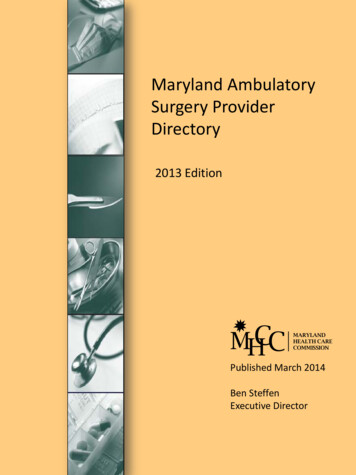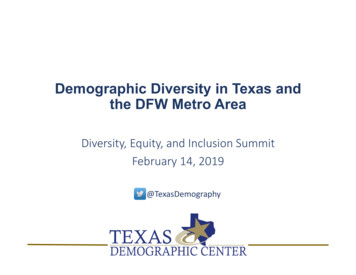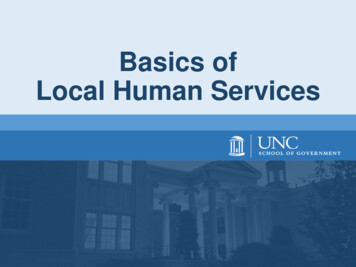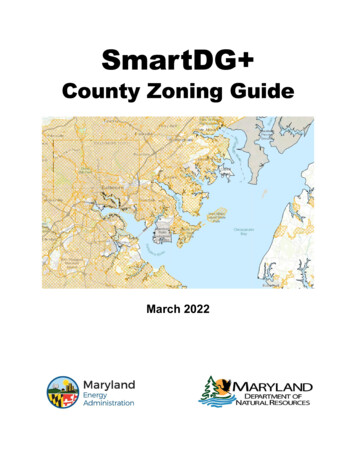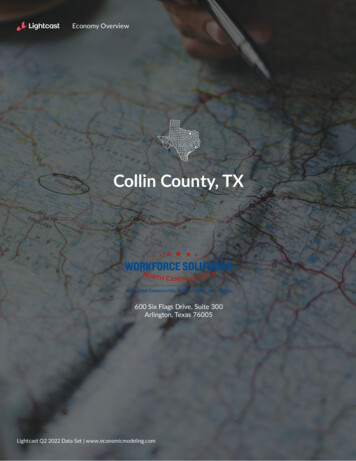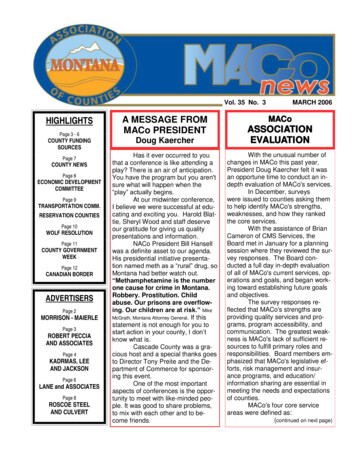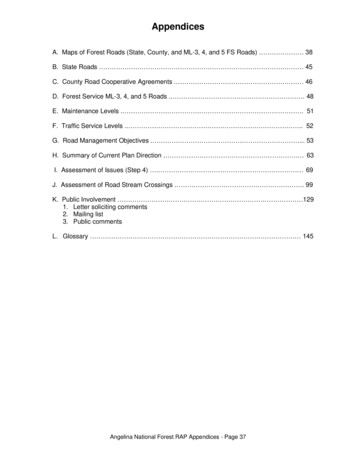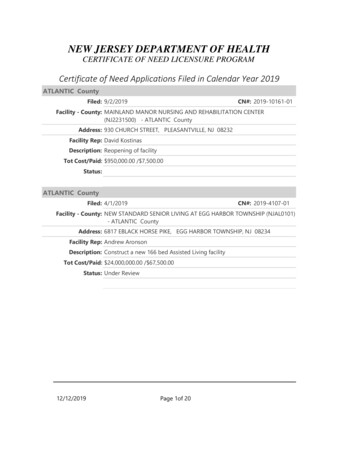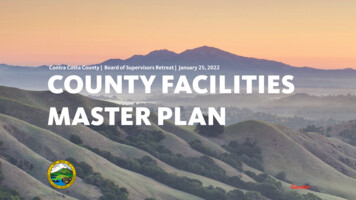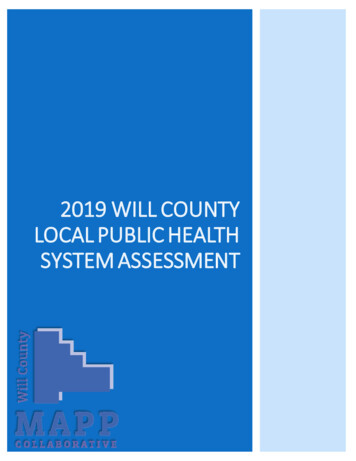
Transcription
2019 WILL COUNTYLOCAL PUBLIC HEALTHSYSTEM ASSESSMENT
Table of ContentsIntroduction .Executive Summary Assessment Methodology .List of Participating Agencies List of Participants Represented Assessment Results .Essential Public Health Service Scores .Equity Scores Appendix A: LPSHA Online Survey Tool .Page 2Page 3-5Page 6-7Page 8Page 9Page 10-22Page 23-24Page 25-27Page 28-53List of AbbreviationsCHSA .Community Health System AssessmentCTSA .Community Themes and Strengths AssessmentEPHS Essential Public Health ServiceFOCA .Forces of Change AssessmentLPHSA Local Public Health System AssessmentMAPP .Mobilizing for Action Through Planning & PartnershipsNACCHO .National Association of County and City Health Officials1 P age
IntroductionThe Will County Local Public Health System Assessment (LPHSA) was conducted in May 2019 as one ofthe four assessments in the Will County Mobilizing for Action through Planning and Partnerships(MAPP) process. MAPP is a community-driven strategic planning framework that guides communitiesin developing and implementing efforts around the prioritization of public health issues andidentification of resources to address them as defined by the 10 Essential Public Health Services. TheMAPP process includes four assessment tools, including the Local Public Health System Assessment.The LPHSA, described in detail in the following section, is used to understand the overall strengths andweaknesses of the public health system based on the 10 Essential Public Health Services. Results fromthe LPHSA will be analyzed with the reports from the other three assessments in the MAPP process,which include the Community Health Status Assessment (CHSA), Community Themes and StrengthsAssessment (CTSA), and the Forces of Change Assessment (FOCA). Strategic analysis of theseassessment results will inform the identification of prevailing issues impacting the health of WillCounty. Issues will be strategically prioritized with consideration of a variety of factors including thecurrent progress and action on the priorities identified from the last assessment and planning cycle.Goals and action plans will be developed or updated for each of these priority health issues. Theseaction plans will be implemented and aligned to improve the local public health system and ultimatelythe health and wellbeing of the Will County community in alignment with our vision.2 P age
Executive SummaryThe Local Public Health System Assessment survey was designed in 2019 to collect data from our localpublic health stakeholders, policy makers, health professionals and collaboratives to address essentialpublic health service needs and gaps that may exist within the existing public health structure. Thesurvey used on-line data collection. A Survey Monkey questionnaire was distributed to a list ofcommunity members and partners who are part of the local public health system in Will County. Sixtysix total participants responded to questions related to strengths and activities associated withessential public health service frameworks. This survey closed as of May 2019. In an analysis of thelocal public health system, stakeholders were asked to rank, from No Activity to Optimal Activity, theirand/or their organizations involvement in sectors related to innovation, technological advancements,addressing inequities, and surveillance as it related to personal health service exposures. Participantswere individuals whom held roles mainly linking individuals to services, educating and informing thepublic about available public health services. Frameworks associated as follows: EPHS 1: Monitoring Health StatusEPHS2: Diagnoses and Investigating NeedsEPHS3: Educate and EmpowerEPHS4: Mobilize PartnershipsEPHS5: Develop policies/plansEPHS6: Enforce LawsEPHS7: Link to Health ServicesEPHS8: Assure WorkforceEPHS9: Evaluate ServicesEPH10: Research/Innovate StrengthsEPHS10: Research/InnovateStrengthsEPHS 6: Enforce LawsEPHS 9: Evaluate ServicesWeaknessesEPHS 7: Link ServicesEPHS 8: Assuring WorkforceOpportunitiesEnforce Laws and createSupport collaborative researchpolicies that arethat is inclusive to the equitycomprehensive to the goalsdevelopment of theand objectives created by the communityhealth care systemThreatsCommunity insecurities withWorkforce Developmentthe goals and objectives of the inclusive of the diversity of thehealth systemcommunityEngaging the community inpolicy and regulation designCommunity may havechallenges obtaining servicesdue to social determinantsUtilize more robust andubiquitous social platformsIntegrating the necessaryTechnologies and Resourcesrequired to maintain astandard of service3 P age
Mobilize the health caresystem to assess and report oncross cutting public healthissuesMonitor and Surveillanceinequities, emerging threatsand respond with adequateand efficient information tothe vulnerable populationsCollaborating and aligning adequate training for workforce tosupport health service linkageA SWOT analysis is depicted above related to the essential public health services and theresponses from the survey. The threats and opportunities mentioned above will enhance futurestrategic planning in Will County to improve the health and overall quality of life for Will Countyresidents.2019 EPHS Framework Scores (Mean)EPHS 10EPHS 9EPHS 8EPHS 7EPHS 6EPHS 5EPHS 4EPHS 3EPHS 2EPHS 10%10%Optimal Activity20%30%Significant Activity40%Moderate Activity50%60%Minimal Activity70%80%No ActivityThe table above depicts the 10 essential public health service frameworks that mold the systemassessment to diversity and reduce error to the data collection mechanisms and provide acomprehensive schematic of the areas required for focus.Essential Public Health Services yielded most Activity:Optimal Activity established from the survey stemmed from EPHS framework 6; mostorganizations that participated felt that their activity related to enforcement and regulation oflaws and policies was optimal.Essential Public Health Services yielded least Activity:4 P age
No Activity was attributed to EPHS framework 8, Assuring a complete and competentworkforce.2019 LPHS Equity ScoresEquity Research CollaborationDelivery of EPHSPublic Health Leadership DevelopmentEquity to Access of ServicesIdentify MarginalizationInclusive PolicyInclusive PartnershipsInform, Educate, Empower on Social DeterminantsMonitor/Surveillance EquityEquity Assessments0%Optimal ActiviySignificant Activity20%Moderate Activity40%Minimal Activity60%80%No ActivityThe table above depicts the scores related to equity and social determinants as they apply to ourpublic health system of care deliverance. Equity addresses disease through surveillance and advocacy,inclusive of youth and racial and ethnic approaches to health.Equity measured most optimally within the framework: Inclusive Policy Inclusive PartnershipsEquity measured least activity or no activity within the framework: Developing a leadership workforce representative of communitySurvey questions related to EquityQ 23 Monitor Equity via AssessmentsQ 49 Identify and Report on Health Equity through surveillanceQ 48 Inform, Educate, and Empower regarding Social Determinants of HealthQ19 Inclusive Community PartnershipsQ26 Participatory Policy Development5 P age
Q30 Impact of Disproportionate and Marginalized CommunitiesQ41 Evaluate equitable access to health servicesQ38 Public Leader DevelopmentQ34 Workforce Gaps in Delivery of ServicesQ36 Support Research CollaborationAssessment MethodologyUsing the National Associate of County & City Health Officials (NACCHO) Local Assessment Instrumentas a guide, a small workgroup convened in April 2019 to select questions from each of the 10 EssentialPublic Health Services (EPHSs) to enter into an online survey collector, Survey Monkey. The onlineinstrument is framed around the 10 Essential Public Health Services (EPHSs) that are utilized in the fieldto describe the scope of public health. The 10 EPHSs support the three core functions of public health:assessment, policy development, and assurance.The 10 EPHSs are defined as:1. Monitor health status to identify communityhealth problems.2. Diagnose and investigate health problems andhealth hazards in the community.3. Inform, educate, and empower people abouthealth issues.4. Mobilize community partnerships to identify andsolve health problems.5. Develop policies and plans that support individualand community health efforts.6. Enforce laws and regulations that protect healthand ensure safety.7. Link people to needed personal health services andassure the provision of health services.8. Assure a competent public and personal healthcare workforce.9. Evaluate effectiveness, accessibility, and quality ofpersonal/population-based health services.10. Research for new insights and innovative solutionsto health problems.Additionally, the 2019 Will County LPHSA included supplemental questions for each EPHS to identifyhow well the LPHS acknowledges and addresses health inequities. The LPHSA supplement is called“System Contributions to Assuring Health Equity,” from the National Association of County and CityHealth Officials (NACCHO) MAPP User’s Handbook. This supplement was also used for the 2016 WillCounty LPSHA.6 P age
The online survey was designed to elicit feedback on each EPHSs using the same rating scale to assessthe model (1-25%)NoActivity(0%)The public health system is doing absolutely everything possible for this activityand there is no room for improvement.The public health system participates a great deal in this activity and there isopportunity for minor improvement.The public health system somewhat participates in this activity and there isopportunity for greater improvement.The public health system provides limited activity and there is opportunity forsubstantial improvement.The public health system does not participate in this activity at all.On May 8, 2019, the Will County MAPP Collaborative distributed the Local Public Health SystemAssessment online. This survey was distributed to a wide-variety of stakeholders (see Appendix A) thatwere suggested using the MAPP User’s Handbook (NACCHO). An email was sent and invitedparticipation in the survey though Survey Monkey to rate the overall strengths and weaknesses of theWill County’s public health system.The survey was divided into two sections: reviewing the Essential Public Health Services and HealthEquity. The opening page of the survey explained the purpose of the assessment as well as the modelstandard prompt rating that would be used for each question. Respondents were then directed to thefirst question which asked participants to choose an essential health service (EHS) that aligns with theirjob duties within the local public health system. Once the respondent selected an EHS, the respondentwas taken to a series of questions related to that EHS. Respondents were also given option tocomment on their response for clarification purposes. Once completed, the respondent was againasked to select an additional EHS that aligned with their job duties or the respondent had theopportunity to exit that section of the survey if they did not have feedback on an additional EHS. Oncethe respondent completed as many EHS questions, the survey directed all participants to the fiveHealth Equity questions. Upon completing the Health Equity questions, the respondents were askedfor their name, job title, program, organization, email address and phone number.7 P age
Sixty-six responses were collected during the duration of the survey. The deadline to complete thissurvey was May 29, 2019. Survey results were analyzed by the Data, Monitoring and Evaluation (DEM)team. A draft Local Public Health System Assessment was presented to the MAPP ExecutiveCommittee for review and approval on July 17, 2019.List of Participating AgenciesAAAAgape Missions, NFPAMITA HealthCornerstone ServicesEasterseals Joliet Region Inc.Edward Elmhurst HealthHines VAJoliet Park DistrictLewis UniversityNew Lenox Fire DepartmentSenior Services of Will CountySilver Cross HospitalStepping StonesSymetria RecoveryWELLPATHWill County BoardWill County Health DepartmentWill County Center for Community ConcernsWill County Community Health ClinicWill County Executive OfficeWill-Grundy Medical ClinicWilmington Coalition for a Healthy CommunitySixty-six individuals participated in this survey of twenty-one agencies. The agencies that wererepresented for this survey are listed above.8 P age
Participants represented Constituency represented Universities/Educational Organizations Community Health/Health Department Community Member Departments of Parks and Recreation Department of Veteran Affairs Public Safety Epidemiology/Communicable Disease Human Resources Healthcare systems/clinic, hospital, FQHC Mental/Behavioral Health State, Federal Governing Agency Law EnforcementDepartment of TransportationEmergency Preparedness and ResponseEnvironmental HealthFaith Based OrganizationsHealthcare ProvidersLocal Board, Governance Laboratories Social Services Nutritionist/DieticianParticipants that were surveyed represented the sectors listed above. Communicable Diseaseand Epidemiology was the only sector not represented during this survey cycle.9 P age
Local Public Health System Assessment (LPHSA) ResultsThe LPHSA survey was developed, tested, and released to MAPP members and community partners viaemail on May 8, 2019. In this survey, participants were asked to rate the Essential Health Services thatrelated to their job duties within the local public health system.We received 66 responses. The survey was distributed to roughly 250 participants. Due to potentialsharing of the survey link as well as emails undeliverable, this is a best estimate of distribution. Beloware the survey questions and results.Survey QuestionsThe survey was designed to allow participants to provide feedback on more than one Essential HealthService related to their work. Once the participants completed one essential health service’s series ofquestions, they were prompted to select another EHS or select “N/A,” to go to Health Equity section.The chart below details how many respondents provided feedback on each Essential Health Service.Essential Health ServicesEPS 1: Monitor health status to identify community health problems.Number ofsurveyrespondents12EPS 2: Diagnose and investigate health problems and health hazards in thecommunity.EPS 3: Inform, educate, and empower people about health issues.9EPS 4: Mobilize community partnerships to identify and solve health problems.13EPS 5: Develop policies and plans that support individual and community healthefforts.EPS 6: Enforce laws and regulations that protect health and ensure safety.10EPS 7: Link people to needed personal health services and assure the provisionof health services.EPS 8: Assure a competent public and personal health care workforce.38EPS 9: Evaluate effectiveness, accessibility, and quality of personal/populationbased health services.EPS 10: Research for new insights innovation solution to health problems.103179910 P a g e
EHS #1: Monitor Health Status to Identify Community Health ProblemsFour questions were chosen to assess the Essential Health Service #1. The highest rated modelstandard was the question regarding the LPHS conducting regular community health assessments toanalyze health data. Over 54% of those who responded to that question felt that the LPHS performs atan optimal level with little or no need for improvement. The greatest area of opportunity within thisEHS is to utilize the best technology and methods to display the data. There were no optimal ratingson this question with the majority scoring this standard as moderate or significant (36.4% for eachrating). There was a divide on if the LPHS analyzes health data to see where problems existgeographically. The majority (36.4%) thought there was minimal activity, but quite a few selected thatthe LPHS was at the optimal level (27.3%). There were no comments or qualitative data provided byrespondents in this section.100Q2 Conduct regular community healthassessments to analyze health data includinggeographic information to see where theproblems exist?5027.27054.550No ficantActivityOptimalActivityQ3 Promote the use of the communityhealth assessment among communitymembers and partners?1005000No 7.27SignificantActivity45.45OptimalActivityQ4 Use the best available technologyand methods to display public health36.3636.3627.27data?00No ActivityOptimalActivity11 P a g e
Q5 Analyze health data, includinggeographic information, to seewhere health problems 27Moderate SignificantActivityActivity27.27OptimalActivityEHS #2: Diagnose and Investigate Health Problems and Health Hazards in the CommunityThere were five questions regarding the EHS #2. The highest rated model standard by participants wasthe LPHS’s ability to rapidly respond to public health emergencies according to guidelines. Over 55% ofthe participants rated this model service at an optimal level with little or no room for improvement inactivity. The questions in the EHS that showed the most opportunity for improvement was evaluationof incidents effectiveness and opportunities for improvement as well as access to laboratories that canmeet routine and emergency needs. There were no comments or qualitative data provided byrespondents in this section.Q7 Participate in a comprehensive surveillancesystem with national, state, and local partnersto identify, monitor and share information andunderstand emerging health problems andthreats?10055.565000No 2.22SignificantActivityOptimalActivityQ8 Provide and collect timely and completeinformation on reportable diseases andpotential disasters, emergencies, andemerging threats?10055.5650022.2222.220No tActivityOptimalActivity12 P a g e
Q9 Prepare to rapidly respond to publichealth emergencies according to guidelines?1005000No 2.22SignificantActivity55.56OptimalActivityQ10 Evaluate incidents for effectivenessand opportunities for improvement?10050011.11No SignificantActivity22.22OptimalActivityEHS #3: Inform, Educate, and Empower People about Health IssuesThere were four questions for EHS #3. The highest rated model standard with the majority ofrespondents said the LPHS was performing at a significant level of activity (55.6%) was providingpolicymakers, stakeholders and the public with ongoing analyses of community health status andrelated recommendation for health promotion policies. The model standard with the mostopportunity for improvement are engaging the community in setting benchmarks, developing plansand implementation. There were no comments or qualitative data provided by respondents in thissection.Q13 Provide policymakers, stakeholders, and the public with ongoinganalyses of community health status and related recommendationsfor health promotion policies?10055.5614.8100No Activity22.227.41Minimal Activity Moderate Activity Significant Activity Optimal ActivityQ14 Engage community in the process of setting priorities,developing plans and implementation of health educationand promotion activities?1005007.41No Activity14.81Minimal Activity29.6344.44Moderate Activity Significant Activity3.7Optimal Activity13 P a g e
Q15 Use different media providers to sharehealth information ?1005018.523.70No icantActivityOptimalActivityQ16 Develop an emergencycommunications plan for emergencies toallow for effective dissemination ofinformation?10048.1550044.4418.5214.8111.11No gnificantActivityOptimalActivityEHS #4: Mobilize Community Partnerships to Identify and Solve Health ProblemsThere were two questions used to rate EHS #4. Both questions scored well with the highest majority ofrespondents rating the model service as significant. There was one qualitative comment sharedregarding budget reductions impairing stakeholder's participation in community health improvementactivities.Q18 Encourage stakeholders to100participate in activities to improvecommunity health?5001005000No ficantActivity15.79OptimalActivityQ19 Establish community partnershipsand stategic alliances to provide acomprehensive approach to improvinghealth in the community?0No ty14 P a g e
EHS #5: Develop Policies and Plans that Support Individual and Community Health EffortsThere were four questions to rate the activities for EHS #5. The highest scoring model service with themajority of respondents choosing a significant level of activity (54.5%) or an optimal level (18.2%) ofactivity was the LPHS activity to develop an emergency preparedness and response plan that is testedwith regular drills. Participants rated the model standard related to the resources allocated to thehealth department as an opportunity for improvement with the majority of respondents choosing theminimal (33.3%) or moderate (50%) level of activity. There was one comment regarding the need tobetter inform the community of public health issues.Q21 Ensure that the local public healthdepartment has enough resources to do itspart?10005033.335016.670No Activity0OptimalActivityQ22 Alert policymakers and the community ofthe possible public health effects (intendedand unintended) from current and/orproposed policies?10033.335033.3333.33000No ActivityOptimalActivityQ24 Develop an emergency prepardnessand response plan that is tested throughregular drills?100018.1809.0954.5518.18No Activity Minimal Moderate Significant OptimalActivity Activity Activity Activity15 P a g e
Q23 Establish a Community HealthImprovement Plan (CHIP) with broad baseddiverse participation, to develop strategiesand accountability for organizations?10058.335000No .33SignificantActivityOptimalActivityEPS 6: Enforce laws and regulations that protect health and ensure safetyThe LPHSA survey asked two questions regarding the enforcement of existing laws, regulations, andordinances that protect health and ensure safety, shown graphically below. Individual responsesindicate that nearly 44% of participants recognize their existing laws, regulations and ordinances asSignificant, followed by Optimal (34%) and lastly Moderate at (22%). No responses were indicated forminimal or no activity. When asked the level of education individuals and organizations promoterelated to relevant laws, regulations and ordinances, 44% selected that their education was Optimalwith Moderate coming in after at 33% and a divide for last with 11% of individuals perceiving theireducation efforts to be significant or minimal. No comments were indicated for this section.100Q27 Review Existing Public Health Laws,Regulations, Ordinances at least every 3-5Years?44.445000100No tActivityOptimalActivityQ28 Educate Individuals andOrganizations about relevant Laws,Regulations, and Ordinances?0033.3322.22No 1.11SignificantActivity44.44OptimalActivity16 P a g e
EPS 7: Link people to needed personal health services and assure the provision of health servicesIdentifying groups of individuals having difficulty accessing or connecting to personal health serviceswas asked to participants, with the majority (52%) perceiving this to be a significant strength and 32%perceiving this to be a moderate strength of their organization. Comments indicated that participantsfelt that barriers existed in combining both mental health and medical health services in facilities andlack of transportation to assist socioeconomically vulnerable populations. Lack of providers topopulation ratio was also discussed. 42% of participants felt that they moderately link individuals tohealth services, while 39% indicated that they significantly link individuals to health services withintheir community. Less than 10% of participants indicated that they Optimally link patients to healthservices.Q30 Identify groups of people in thecommunity that have trouble accessingpersonal health services?10050032.260No tySignificantActivityOptimalActivityQ31 Understand the reasons thatpeople do not get the care they need?1005001005000No .843.23SignificantActivityOptimalActivityQ32 Connect or link people toorganization that can provide personalhealth services they may need?0No .71SignificantActivity9.68OptimalActivity17 P a g e
EPS 8: Assure a competent public and personal health care workforceA comprehensive workforce is essential to health services adherence. Participants were asked to rankthe level of activity associated with their organizations ability to identify gaps in the local public healthworkforce from Optimal to No Activity. 43% of individuals responded that they perceived theirorganization to provide significant activity in providing a competent workforce, 23% indicatedmoderately comprehensive, and 14% perceiving their efforts to be minimal or non-existent. Whenverifying for required certification, licensures and education required for workers, 50% of participantsindicated that they Optimally verify that staff are competent for their roles. An even divide at 12.5%was indicated for significant, moderate, minimal, and no Activity. When asked to indicatecollaborations among organizations for training and continued education, participants perceived theircontributions at significant (63%), and 25% perceiving their efforts for continued education amongstworkforce as minimal, while 37% perceived the training of cultural competency in their workforce tobe significant and 57% perceived the inclusiveness of diversely represented leadership skill building asa significant focus.Q34 Complete a workforce assessmentto identify and address gaps in the localpublic health workforce?10050014.29No ivitySignificantActivityOptimalActivityQ35 Ensure that all members of the local publichealth workforce have the required certificates,licenses, and CEU's needed to fulfill thier jobduties ?1005014.290No cantActivityOptimalActivityQ36 Create and support collaborations amongorganizations for training and education?62.50014.2942.8628.57No ificantActivityOptimalActivity18 P a g e
100Q37 Continually train the public healthworkforce to deliver services in a culturallycompetent manner and understand the social62.5determinates of health?500No Activity12.50MinimalActivityModerate SignificantActivityActivityOptimalActivityQ38 Provide opportunities for the developmentof leaders who represent the diversity of thecommunity?10050025062.5250No Activity12.50MinimalActivityModerate SignificantActivityActivityOptimalActivityEPS 9: Evaluate effectiveness, accessibility, and quality of personal/population-based health servicesEvaluating the effectiveness of population-based health services for outcomes provides an evidencebased approach to understanding needs, gaps, and accurate advocacy. Less than 10% of theparticipants perceived the effectiveness of their services at optimal, while 55% rated their efforts assignificant and 36% rated their efforts as moderate. No participants indicated minimal or no activity inevaluating the effectiveness of services. User satisfaction was similar, with 64% perceiving usersatisfaction of clients as significant and 37% as moderate. 80% of responders indicated that they arecurrently utilizing technology to the administration of and improvement of quality of care.Q40 Evaluate how well populationbased health services are working?1005000No tivitySignificantActivityOptimalActivityQ41 Evaluate the accessibility,quality, and effectiveness of62.5personal health services?0NoActivity25MinimalActivity0Moderate SignificantActivityActivity12.5OptimalActivity19 P a g e
Q42 Measure user satisfactionwith personal health 0Moderate SignificantActivityActivityOptimalActivityQ43 Use technology to improvequality of care?800063.64No cantActivityOptimalActivityEPS 10: Research for new insights and innovative solutions to health problemsIndividuals were asked to rank their attentiveness to innovation within their agencies andorganizations from No Activity to Optimal Activity; seven questions were asked in relevance to this.Less than 12% of all participants felt that activities related to innovation, surve
The Local Public Health System Assessment survey was designed in 2019 to collect data from our local public health stakeholders, policy makers, health professionals and collaboratives to address essential

